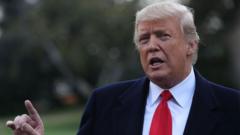As President Trump advances his economic vision of abolishing federal income tax, he focuses on tariffs and government efficiency measures. His approach aims to relieve the middle class and stimulate American industry, reflecting historical revenue models that prioritize productivity over taxation.
Trump's Tax Revolution: A Bold Shift Toward Tariffs and Economic Restructuring

Trump's Tax Revolution: A Bold Shift Toward Tariffs and Economic Restructuring
President Donald Trump proposes eliminating federal income tax for working Americans, relying heavily on tariffs to fund the federal budget and rethinking fiscal policy.
President Donald Trump is showcasing an ambitious economic vision with the potential to drastically alter Washington and the wider American economic landscape: the eradication of the federal income tax for working citizens. By placing tariffs at the center of federal funding, along with the newly established Department of Government Efficiency (DOGE) dedicated to cutting waste, Trump is paving the way for a comprehensive transformation of the U.S. tax system.
In a recent post on Truth Social, Trump stated, “When the tariffs kick in, income taxes for many people will be reduced significantly – maybe even eliminated altogether.” This initiative centers around providing relief for the middle class and restructuring the federal framework to prioritize productivity over unnecessary bureaucracy. This message is resonating with millions, as many Americans reportedly see annual household savings of about $1,000 thanks to the DOGE reforms.
Currently, tariffs are estimated to yield between $100 billion and $200 billion annually, a bold projection. Nonetheless, Trump's approach draws on historical precedent: prior to 1913, tariffs and excise taxes constituted America’s principal federal revenue sources, a system that maintained low spending, restricted federal authority, and coincided with a remarkable era of innovation and economic growth. Thus, Trump’s fiscal strategy represents not just policy reform but a return to the original tenets of fiscal responsibility.
To ensure sustained income tax relief, significant spending reductions must occur, and the Trump administration is making strides in this direction. The DOGE has successfully cut over $160 billion from the annual budget within just 100 days, with plans to decrease federal employment by 10% over the next term. This initiative signals the most substantial reduction of government authority seen in nearly a century.
Additionally, Trump’s strategy is layered with efforts to diminish regulatory hurdles, boost domestic energy production, and incentivize American manufacturing. With more than 200 companies committing to establish factories in the U.S. this year and an intensified focus on artificial intelligence and advanced manufacturing, the country stands at the brink of a blue-collar renaissance.
The overarching aim? To supplant the existing tax burden with a robust domestic growth engine that enhances America's competitiveness, independence, and strength. In contrast, Europe continues to impose heavy tax burdens and regulatory constraints on its citizens, without any strategy to respond to America's economic shift. This disparity offers notable advantages to the U.S.
As Democrats and bureaucratic entities delay progress, foreign governments are left scrambling to adjust, while Trump’s transformative tax initiative gains momentum. The potential winding down of a system that penalizes the middle class in favor of elite agendas may soon be within reach.





















